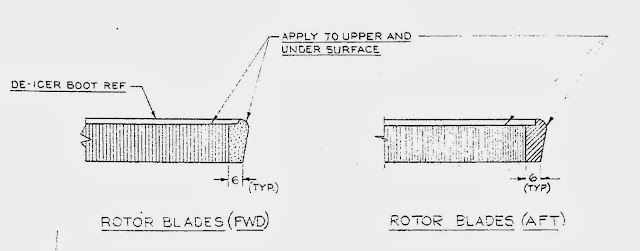Blades
When initially purchased, both Canadian H-46 variants were fitted with the same blades. As is evident in the technical drawings below, both variants had blade tips that were not square. This style blade is accurately depicted in the Airfix/MPC model kits only.
Eventually, the blades were changed to
those with tips that were squared off although the blade chord did not change
as far as I am aware. This is where the similarities between Labrador blades
and Voyageur blades end. Structurally they were the same blade visually they
were somewhat different; most notable was the colour of the blade tips. On both
variants, the forward tips were yellow while the aft blade tips were red. In
both cases the tips were painted for the last six inches only with the
measurement being made at the trailing edge of the blade. For the purist, the
tips colours for both variants were yellow 5-2 and red 9-2.
Early Labrador blades were initially black
on the top and bottom with a narrow strip of bare metal, the deicer
boot…something Voyageur blades did not have, along the leading edge of the
blade. Voyageur blades were painted green 3-17 on top and like the Labrador the
black was 10-201 on the underside.
For aircraft 313, the only airframe painted
in the variegated camouflage livery, blade colours followed the same pattern as
above for tip colour and the top and bottom of the blade. The only difference
being the upper blade surfaces were painted green 3-213, not green 3-17. I am
presuming green 3-213 is the same colour as the green in the camouflage.
Second-generation blades were metal, but
instead of black they were painted aluminum on top and black on the underside.
The difference between the first and second-generation blades lies in the
ability of the second-generation blade to give aircrew the ability to detect
blade problems. The most likely problem being cracks in the skin of the vacuum
blades. Sometime after taking delivery the Canadian military, installed on each
blade, a sensor with a moveable
component to indicate a difference in pressure of the sealed blade. The newly
fitted “Integral Spar Inspection System” (ISIS) alerted the crew to a cracked blade
during any of the numerous scheduled inspections. When the pressure inside the
blade dropped the moveable component presented what was called a “black” blade
leading to a blade change. I have heard stories from older aircrew that the
very first blades had to be checked almost constantly resulting in unscheduled
landings signaled by a vibration or handling anomaly. In any, case the new
detection system called “ISIS” was identifiable on the blades by the “ISIS
indicators” located on the underside and near the root the blade. ISIS was
fitted on the blades of both Canadian variants.
The only real good picture of the ISIS indicator I could find.
Jeff Wilson's picture show's the underside of an aft blade and a clear view of the red blade's ISIS indicator and a slightly obscured profile look at the green blade's ISIS indicator.
As the helicopters went through the various
upgrades, new blades were for a second time installed. The old hollow metal
blades being replaced by composite fiber blades that while the same length were
wider and heavier by several pounds.
Additionally, where the earlier blades had but one trim tab, it is my
understanding, the composite blades had two or perhaps three adjustable trim
tabs, although for now I cannot verify this. The composite blades were solid so
no longer required ISIS indicators.
306
sitting on the ramp after flailing itself with the new composite blades. When
304 did the same thing (twice actually) the first time with metal blades,
pieces of blade and helicopter were literally sent flying throughout the base (Comox).
DND Photo
As I searched for 113 model reviews on the
Internet, it dawned on me that comment was required on the need to ensure the
counter rotating blades are located correctly. From the pilot’s position,
looking forward, the forward blades rotate to the left (counter clockwise) and
the aft rotors to the right (clockwise).!







No comments:
Post a Comment